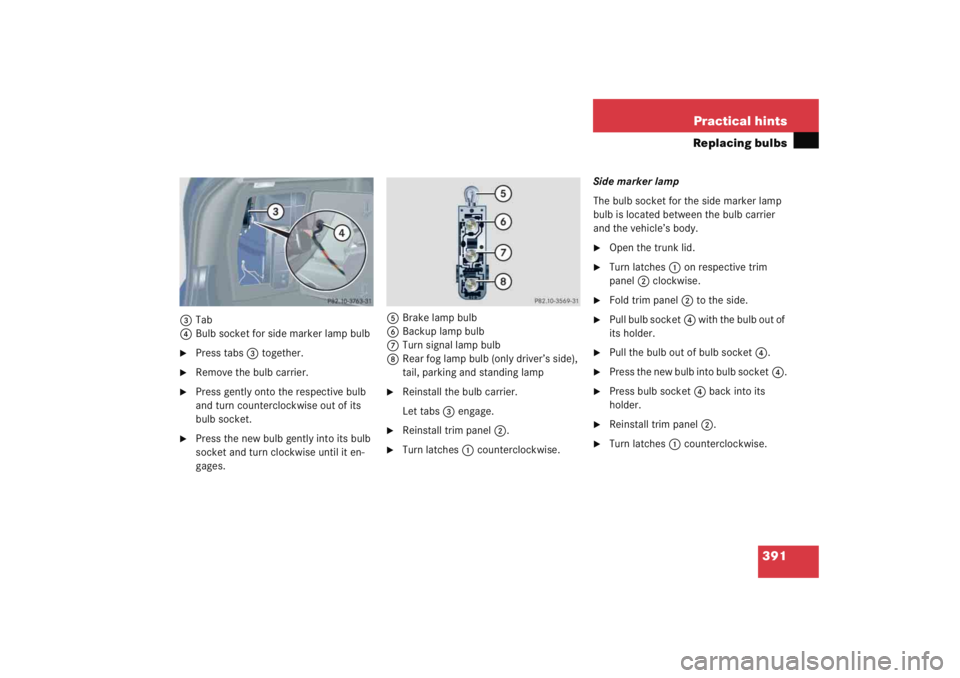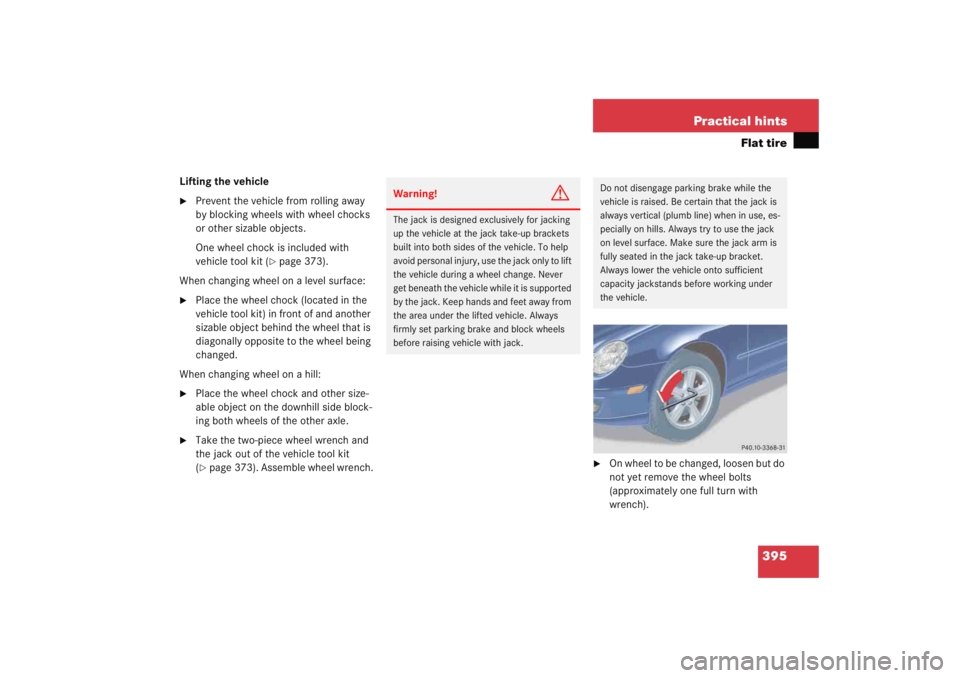Page 343 of 474

342 Practical hintsWhat to do if …Problem
Possible cause
Suggested solution
ú
(USA only)
±
(Canada only)
The yellow engine
malfunction indicator
lamp comes on while
driving.
There is a malfunction in:�
The fuel management system
�
The ignition system
�
The emission control system
�
Systems which affect emissions
Such malfunctions may result in ex-
cessive emissions values and may
switch the engine to its limp-home
(emergency operation) mode.
�
Have the vehicle checked as soon as possi-
ble by an authorized Mercedes-Benz Center.
An on-board diagnostic connector is used
by the service station to link the vehicle to
the shop diagnostics system. It allows the
accurate identification of system
malfunctions through the readout of
diagnostic trouble codes. It is located in the
front left area of the footwell next to the
parking brake pedal.
A loss of pressure has been detect-
ed in the fuel system. The fuel cap
may not be closed properly or the
fuel system may be leaky.
�
Check the fuel cap (
�page 288).
If it is not closed properly:
�
Close the fuel cap.
If it is closed properly:
�
Have the fuel system checked by an
authorized Mercedes-Benz Center.
Your fuel tank is empty.
�
After refuelling start, turn off and restart the
engine three or four times in succession.
The limp-home mode is canceled. You do not
need to have your vehicle checked.
Page 359 of 474

358 Practical hintsWhat to do if …Display symbol
Display message
Possible cause
Possible solution
!
(Canada only)
;
(USA only)
Parking brake
Release brake.
You are driving with the parking brake
set.
�
Release the parking brake
(�page 50).
2
Brake wear
Visit workshop.
The brake pads have reached their wear
limit.
�
Have the brake pads replaced as soon
as possible.
;
(USA only)
3
(Canada only)
Brake fluid
Visit workshop.
There is insufficient brake fluid in the
reservoir.
�
Risk of accident! Stop the vehicle and
notify an authorized Mercedes-Benz
Center. Do not add brake fluid! This
will not solve the problem.
Warning!
G
Driving with this message displayed can
result in an accident. Have your brake
system checked immediately. Do not add
brake fluid before checking the brake
system. Overfilling the brake fluid reservoir
can result in spilling brake fluid on hot
engine parts and the brake fluid catching
fire. You can be seriously burned.
!If you find that the brake fluid in the
brake fluid reservoir has fallen to the
minimum mark or below, have the
brake system checked for brake pad
thickness and leaks.
!Brake pad thickness must be visually
checked by a qualified technician at the
intervals specified in the Maintenance
Booklet.
Page 375 of 474

374 Practical hintsWhere will I find ...?Vehicle jack
Storage position�
Remove the vehicle jack from the spare
wheel well under the trunk floor.
�
Push the crank handle up.
�
Turn the crank handle clockwise until it
engages (operational position).
Before storing the vehicle jack in its com-
partment:
�
It should be fully collapsed.
�
The handle must be folded in (storage
position).
Warning!
G
The jack is designed exclusively for jacking
up the vehicle at the jack take-up brackets
built into both sides of the vehicle. To help
avoid personal injury, use the jack only to lift
the vehicle during a wheel change. Never
get beneath the vehicle while it is supported
by the jack. Keep hands and feet away from
the area under the lifted vehicle. Always
firmly set parking brake and block wheels
before raising vehicle with jack.
Do not disengage parking brake while the
vehicle is raised. Be certain that the jack is
always vertical (plumb line) when in use, es-
pecially on hills. Always try to use the jack
on level surface. Make sure the jack arm is
fully seated in the jack take-up bracket. Al-
ways lower the vehicle onto sufficient ca-
pacity jack stands before working under the
vehicle.
Page 386 of 474
385
Practical hints
Replacing bulbs
Front lamps
Rear lamps
Lamp
Type
1
Additional turn signal
lamps
LED
2
Halogen headlamp: Turn
signal lamp
Bi-Xenon* headlamp:
Turn signal lamp
1156 A
2357 A
3
Halogen headlamps:
Low beam
1
Bi-Xenon* headlamp:
Low and high beam
1Vehicles with Bi-Xenon* headlamps: Low beam
and high beam use the same D2S-35W lamp. Do
not replace the Xenon bulbs yourself. See an
authorized Mercedes-Benz Center.
H7 (55 W)
D2S-35 W
Lamp
Type
4
Halogen headlamps:
High beam/high beam
flasher
Bi-Xenon* headlamps:
High beam flasher
H7 (55 W)
H7 (55 W)
Parking and standing
lamps
W5W
5
Fog lamp
Front fog lamp with
cornering fog lamp
HB4 (51 W)
H7 (55 W)
6
Side marker lamp
W5W
Lamp
Type
7
High mounted brake
lamp
LED
8
License plate lamps
C 5 W
9
Brake lamp
P 21 W
Turn signal lamp
PY21W
Tail, parking, standing
and side marker lamp
P21/5W
Rear fog lamp (only
driver’s side)
P21/4W
Page 387 of 474

386 Practical hintsReplacing bulbs
Notes on bulb replacement�
Use only 12-volt bulbs of the same type
and with the specified watt rating.
�
Switch lights off before replacing a bulb
to prevent short circuits.
�
Always use a clean lint-free cloth when
handling bulbs.
�
Your hands should be dry and free of oil
and grease.
�
If the newly installed bulb does not
come on, visit an authorized
Mercedes-Benz Center.
Have the LEDs and bulbs for the following
lamps replaced by an authorized
Mercedes-Benz Center.
�
Additional turn signals in the exterior
rear view mirrors
�
High mounted brake lamp
�
Xenon* lamps
�
Front fog lamps
Replacing bulbs for front lamps
Before you start to replace a bulb for a
front lamp, do the following first:�
Turn the exterior lamp switch to
position M (
�page 110).
�
Open the hood (
�page 291) (except
for side marker lamps).
Halogen headlamps
Left headlamp, mirror-image of right
headlamp1 Housing cover for low beam headlamp
2 Housing cover for high beam head-
lamp, parking and standing lamp
Warning!
G
Bulbs and bulb sockets can be very hot. Al-
low the lamp to cool down before changing
a bulb.
Keep bulbs out of reach of children.
Halogen lamps contain pressurized gas.
A bulb can explode if you�
touch or move it when hot
�
drop the bulb
�
scratch the bulb
Wear eye and hand protection.
Because of high voltage in Xenon lamps, it is
dangerous to replace the bulb or repair the
lamp and its components. We recommend
that you have such work done by a qualified
technician.
Page 392 of 474

391
Practical hints
Replacing bulbs
3
Tab
4 Bulb socket for side marker lamp bulb�
Press tabs 3 together.
�
Remove the bulb carrier.
�
Press gently onto the respective bulb
and turn counterclockwise out of its
bulb socket.
�
Press the new bulb gently into its bulb
socket and turn clockwise until it en-
gages. 5
Brake lamp bulb
6 Backup lamp bulb
7 Turn signal lamp bulb
8 Rear fog lamp bulb (only driver’s side),
tail, parking and standing lamp
�
Reinstall the bulb carrier.
Let tabs 3 engage.
�
Reinstall trim panel 2.
�
Turn latches 1 counterclockwise. Side marker lamp
The bulb socket for the side marker lamp
bulb is located between the bulb carrier
and the vehicle’s body.
�
Open the trunk lid.
�
Turn latches
1 on respective trim
panel 2 clockwise.
�
Fold trim panel 2 to the side.
�
Pull bulb socket 4 with the bulb out of
its holder.
�
Pull the bulb out of bulb socket 4.
�
Press the new bulb into bulb socket 4.
�
Press bulb socket 4 back into its
holder.
�
Reinstall trim panel 2.
�
Turn latches 1 counterclockwise.
Page 396 of 474

395
Practical hints
Flat tire
Lifting the vehicle�
Prevent the vehicle from rolling away
by blocking wheels with wheel chocks
or other sizable objects.
One wheel chock is included with
vehicle tool kit (
�page 373).
When changing wheel on a level surface:
�
Place the wheel chock (located in the
vehicle tool kit) in front of and another
sizable object behind the wheel that is
diagonally opposite to the wheel being
changed.
When changing wheel on a hill:
�
Place the wheel chock and other size-
able object on the downhill side block-
ing both wheels of the other axle.
�
Take the two-piece wheel wrench and
the jack out of the vehicle tool kit
(�page 373). Assemble wheel wrench.
�
On wheel to be changed, loosen but do
not yet remove the wheel bolts
(approximately one full turn with
wrench).
Warning!
G
The jack is designed exclusively for jacking
up the vehicle at the jack take-up brackets
built into both sides of the vehicle. To help
avoid personal injury, use the jack only to lift
the vehicle during a wheel change. Never
get beneath the vehicle while it is supported
by the jack. Keep hands and feet away from
the area under the lifted vehicle. Always
firmly set parking brake and block wheels
before raising vehicle with jack.
Do not disengage parking brake while the
vehicle is raised. Be certain that the jack is
always vertical (plumb line) when in use, es-
pecially on hills. Always try to use the jack
on level surface. Make sure the jack arm is
fully seated in the jack take-up bracket.
Always lower the vehicle onto sufficient
capacity jackstands before working under
the vehicle.
Page 406 of 474

405
Practical hints
Jump starting
The battery is located in the engine com-
partment on the right hand side. The
terminals for jump starting are located in
front of the battery.�
Make sure the two vehicles do not
touch.
�
Turn off the engine.
On both vehicles:
�
Turn off all electrical consumers.
�
Apply parking brake.
�
Shift gear selector lever to position P
(manual transmission to Neutral). 1
Positive terminal of charged battery
2 Positive under hood terminal in front of
discharged battery
3 Negative terminal of charged battery
4 Negative under hood terminal in front
of discharged battery
�
Connect positive terminal 1 of the
charged battery with positive under
hood terminal 2 in front of the dis-
charged battery with the jumper ca-
bles. Clamp cable to charged
battery 1 first.
�
Start engine of the vehicle with the
charged battery and run at idle speed.
�
Connect negative terminal 3 of the
charged battery with negative under
hood terminal 4 in front of the dis-
charged battery with the jumper
cables. Clamp cable to charged
battery 3 first.
�
Start the engine of the disabled
vehicle.
Now you can turn on the electrical con-
sumers. Do not turn on the lights under
any circumstances.
�
Remove the jumper cables first from
negative terminals 4 and 3 and then
from positive terminals 2 and 1.
You can now turn on the lights.
�
Have the battery checked at the
nearest authorized Mercedes-Benz
Center.
Warning!
G
Keep flames or sparks away from battery.
Do not smoke.
Observe all safety instructions and precau-
tions when handling automotive batteries
(�page 297).
!Vehicles with automatic transmission:
Do not tow-start the vehicle.